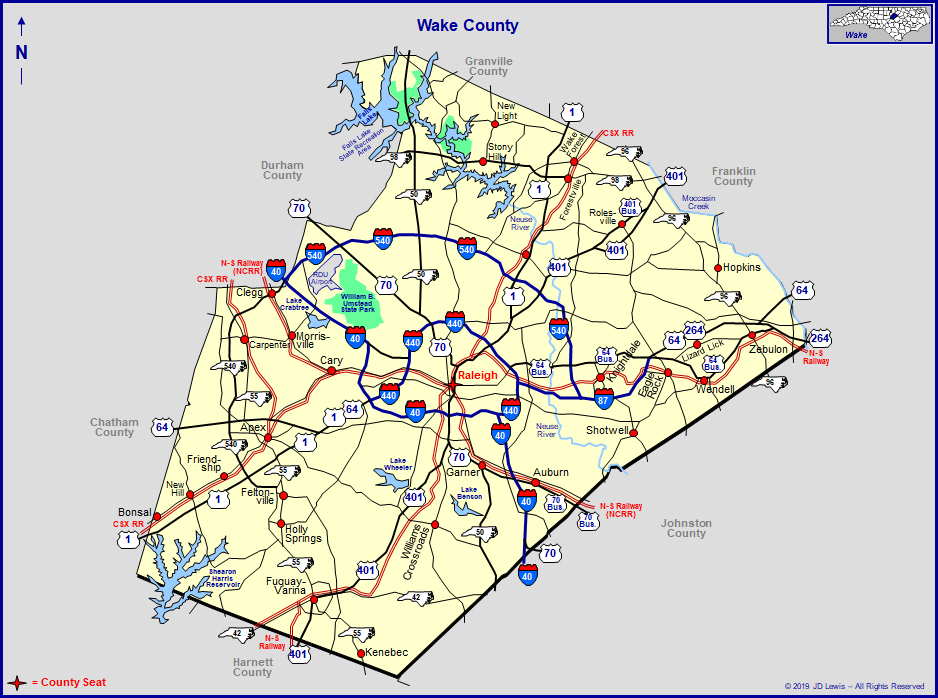 |
||||
|
|
||||
|
|
|
|
|
|
|
|
wife of Governor William Tryon |
|
|
|
|
|
|
|
|
|
|
|

|
|
|
|
|
|
|
|
|
|
|
|
|
|
|
|
|
|
|
|
|
|
|||
 State Capitol Building - Raleigh, North Carolina The first court house was erected at what is known as Bloomsbury. It was called Wake County Court House until 1792, when Raleigh was established and made the county seat as well as the state capital. In 1771, the colonial General Assembly created Wake County from Johnston, Cumberland, and Orange counties. Wake County was named for the London heiress Margaret Wake, wife of the sitting Royal Governor William Tryon. After the American Revolution, the leaders of the state decided to locate the capital of North Carolina here in 1792. Raleigh, though the seat of state and county government, remained a small southern town until the 1920s, and the surrounding countryside remained primarily rural until after World War II. From early settlement in the late-1730s/early-1740s to around the time of the American Civil War, Wake County shared a way of life with most of North Carolina, with its scattered modest-sized farms and sparsely populated communities. Rural localities, each usually containing a church, school, store, gristmill, and (by the early twentieth century) cotton gin, were the hubs of human activity. Farming families raised and produced most, if not all, of their food and apparel, and few ventured far from home to market their surpluses. Following the era of initial settlement, population growth in the county was slow, particularly in the 1820s and 1830s, when many residents moved out of the county to developing areas of the state and nation where fresh land was plentiful and cheap and opportunities were better for commercial farming. Beginning in the 1840s, railroad construction stemmed emigration somewhat by providing some commercial farmers with links to important regional and northern markets. However, although market-oriented agriculture was gaining a foothold, subsistence farming still dominated Wake County rural life.  Wake County Court House (2010) The six decades between the American Civil War and World War I were years of tremendous change in Wake County and throughout North Carolina. Economic pressures, population growth, and increased contact with people outside the state began transforming traditional ways of living. The Civil War and Reconstruction altered both white and black labor systems and generated changes in the South's social and economic structures. An economic system based on tenant labor and the commercial production of cotton and tobacco evolved, which brought prosperity to some farmers but led many into poverty. Wake County's rural landscape became decidedly different during these years, as larger farms were divided and subdivided into smaller farms. The cultivation of tobacco required specialized curing and storage barns, the numbers of which grew exponentially as many farmers turned from cotton to tobacco in the early twentieth century. Commercial and industrial expansion spread throughout the county as more and more railroads were constructed to connect Wake County to important market centers, and towns were established to serve local commercial needs. During the years immediately after the Civil War, there were very few large-scale construction projects in rural Wake County, as the county's citizens struggled to recover from the conflict and its resulting economic problems. By the mid-1880s, however, a period of relative prosperity dawned. Subsistence and diversified farming gave way on many farms to monocrop commercial agriculture. The population and the number of farms increased dramatically and railroads created new towns. At the same time, the size of farms decreased and the number of families who worked as tenants on the farms of others rose steadily. Tremendous numbers of buildings in the county's rural areas and small towns were built from the 1880s to the 1910s, reflecting the architectural transformation that was a part of these enormous changes. The landscape is densely populated with small farmsteads dating from these years, most with simple, conservative houses and farm buildings. The small towns that grew up during the late nineteenth and early twentieth centuries are, for the most part, artifacts of the development that railroads fostered and that cotton and tobacco markets nurtured. An agricultural depression during the early 1920s ended the brief period of rural prosperity after World War I. And as Wake County farmers and townspeople encountered the Great Depression of the 1930s, traditional ways of life began to change more rapidly. Automobiles and better roads encouraged mobility. Federal government limits on cotton and tobacco production levels, as well as the mechanization of farming and the increased use of pesticides, reduced the amount of acreage under cultivation and the number of laborers in the fields. By the time of World War II, a county that was once predominantly rural and agricultural was becoming increasingly urban and oriented toward commercial and industrial interests. Though increasingly urbanized, the Wake County of today still bears some resemblance to its past appearance. Many areas near the edges of the county remain rural, and family and neighborhood networks are still vital to the social fabric of rural communities. A surprisingly large number of traditional farmhouses and farm buildings and small community churches, schools, and stores still dot the landscape, although they are rapidly being replaced or surrounded by subdivisions and shopping centers. Despite all of the growth in recent years, interest in Wake County's rural and small-town heritage thrives, fostered by local historical societies and other public and private groups who promote community pride among old and new residents alike. |
|||
 |
 |
© 2022 - J.D. Lewis - PO Box 1188 - Little River, SC 29566 - All Rights Reserved